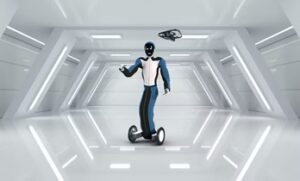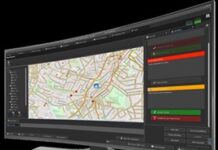
Take a moment to imagine a world without robots. It’s hard, and for many, thinking back to the turn of the 20th century would be a “safe bet” of what a robot-less world might look like. Not primitive, but life required a lot of extra work. However, in 2024, robots are becoming ubiquitous; industrial robots that look nothing like those we’ve seen in popular cinema have revolutionized our world. Often, these robots are hidden from public view while they quietly manufacture our vehicles and pickup orders from the warehouse.
Similarly, security robots were unheard of until about 2014, when a purpose-built security robot was conceived and released to the market to provide security patrols and presence in parking lots and other public venues. While security robots aren’t as prevalent as other industrial robots, they are slowly making headway into corporate security programs.
However, their acceptance in the workplace is sometimes met with employee trepidation. Still, what are these machines designed to do today, and what might they be capable of doing in the next few years? And what is the go-to-market business model for security robots that end-users need to anticipate?
Today, security robots have two and a half distinct form factors with variations and two environments in which they work.
Exterior Robots: Exterior robots entered the market about 10 years ago and are built to manage outside weather conditions with certain limitations. Some are constructed with a bullet-like form factor and are intended to project a security presence when a human guard isn’t available or desirable and provide video surveillance. These robots are limited to constructed areas like parking lots and other paved surfaces. They aren’t rugged enough to “go off-piste” onto uneven or rugged terrain, but there are four-wheel rovers and a robotic canine that can easily manage this type of ground.
Interior Robots: Interior security robots arrived later and were often constructed with bullet-form factors and even kiosk-stanchion forms. Built with the same intention as exterior robots, interior ones are not as well-established in the workplace but are gaining traction.
Humanoid wheeled and bipedal security robots are being developed and are presently in limited workplace distribution. Both versions of humanoid robots appear to be a preference over rover-style robots for those companies evaluating them because they can be effectively socialized into many workplaces, have appendages to manipulate objects within their environment, and, if two-way audio is enabled, provide a more natural conversational experience between a person and the robot or a human operator.
Fixed-in-Place Robots: Fixed-in-place robots lack the mobility that rover and humanoid robots possess, hence the half-form-factor designation. Built with many of the features of a mobile robot, fixed-in-place robots can provide a static, post-like service that a human guard might be responsible for.
In all cases, mobile robots must have essential features and functionalities that end-users expect. Is the robot truly autonomous, and how is that achieved? Can the robot integrate into security and other systems for an optimized alarm or incident response? When interacting with people, will the robot possess a native large language model for a natural human experience with people?
These are just a few of the many expectations of security organizations evaluating the use of robots in commercial spaces today.
Robots are already making a difference in the workplace. Security teams are deploying them in high-security environments that require diligence, 24×7 situational awareness, and the ability to project a security presence to assertively thwart would-be intruders. As the number of interior environment robot offerings improves, they will perform the same role and more than their exterior counterparts. As the robot “learns” the workplace environment, its utility and purpose will improve, thus returning a better return on investment.
The two core functions that interior and exterior robots must have are true autonomous capabilities, including safe mobility and a native large language model for natural bi-directional communication between the robot and a person. In many cases, the current robot offerings require that the manufacturer provide the robot with a command-and-control function, and the dashboard is provided as a service to the end user. In some limited cases, the company’s personnel can control the robot directly, often via a Security Operations Center using virtual technology coupled with the robot’s vision system.
Many manufacturers offer their robots under a leasing program, and the operations are centralized via their Operations Center with a client dashboard to permit view and patrol planning. Lately, a few manufacturers have offered a lease program that permits the end user to have full robot command and control, with diagnostic telemetry sent to the manufacturer as needed. For security teams considering a robotics program, leasing is the predominant method to pay for the service, with a wide variety of robotic operational configurations available to suit virtually all use cases. Manufacturers are investing in improved robotics technology, including humanoid bipedal forms, artificial intelligence, better computer vision, native large language models, and true, effective autonomy. Integration into an existing security system is ideal but not strictly necessary for the role and purpose of the robot to perform its daily tasks effectively.
Security robots are here, and their presence will continue to grow as end users face guard staffing shortfalls and the requirement to expand the activities and performance of security operations to help protect the organization from known and emerging threats. While not as ubiquitous as industrial robots, for example, security robots in the workplace will continue to grow until—yes—we can’t imagine them not being there.











